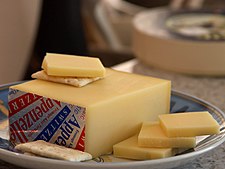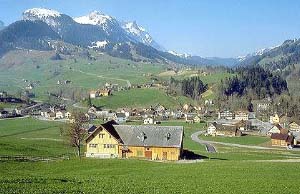Appenzeller (cheese)
Appenzeller cheese is a hard cow's-milk cheese produced in the Appenzell region of northeast Switzerland. A herbal brine, sometimes incorporating wine or cider, is applied to the wheels of cheese while they cure, which flavors and preserves the cheese while promoting the formation of a rind.
Appenzeller has a documented history of at least 700 years. Today, about 75 dairies produce it, each with a different recipe for their brine wash. Most of the recipes are trade secrets.
The cheese is straw-colored, with tiny holes and a golden rind. It has a strong smell and a nutty or fruity flavor, which can range from mild to tangy, depending on how long it is aged. Three types are sold:
Regarded by cosmopolitan urbanites as the epitome of country bumpkin-ness and mercilessly mocked for its folksy ways, Appenzellerland is the stuff of jokes in Switzerland. Yet although a sophisticated Lausannois or Basler might chortle to hear it, the region is actually something of a sensuous delight: as you cross the verdant hills south from St Gallen, the pungent smells of cows and cheese assault your nose; on a wander through the villages, busy embroidery and the fussily net-curtained windows of wooden houses delight the eye; and local cooking, particularly rich with butter and cream, has a delicious silkiness.
Encircled by rolling hills, with the looming snowy peaks of the Alpstein ridges to the south, Appenzell has for centuries been a land apart. Monks from St Gallen colonized the area in the tenth century, calling it Abtszell or Abbey Cell, but the local fiercely independent peasantry threw off ecclesiastical control in a series of wars in the fourteenth century. Although surrounded by St Gallen’s territory, Appenzell joined the Swiss Confederation in 1513, long before its more powerful neighbour. Shortly afterwards it split into two tiny autonomous half-cantons – Protestant Ausserrhoden, and Catholic Innerrhoden. For touristic purposes, the two half-cantons are together dubbed Appenzellerland, but the divisions between them remain to this day, with Ausserrhoden’s dynamic economy based on manufacturing industry and Innerrhoden’s more languorous one based on tourism and the preservation of traditional culture and crafts.
Appenzell village, 20km south of St Gallen and the capital of Innerrhoden, the least populous of all Swiss cantons, is the main draw of the area for its quaint, traditional air – preserved even amidst the hordes of high-season day-trippers. Previously accessible via a series of winding backcountry lanes, the village was only recently connected by train to the national network. Other than Stein’s excellent museum and show dairy, surrounding villages hold few attractions, but there’s plenty of excellent hill walking, with routes crossing the velvety green hills around Appenzell and south to the higher, rocky peaks of the Alpstein and its highest point, the snowy Säntis (2502m).
The main street of APPENZELL is car-free Hauptgasse,running from a bridge over the River Sitter at the entrance to the village west for 300m or so to the broad, open Landsgemeindeplatz; it’s worth a wander along to admire the intricately painted old wooden houses with their rows of small, closely packed windows – Löwen Drogerie, a pharmacy at no. 20, has a particularly gorgeous facade with depictions of herbs and flowers. During the eighteenth and nineteenth centuries, the embroidery industry of nearby St Gallen relied upon thousands of women working by hand from home, with the intricate embroidery of Appenzell particularly highly prized: the upstairs rooms in these buildings, flooded by daylight through the lines of windows, were used as workshops. Hand-embroidery flourished into the first half of the twentieth century, and is still carried on by a few specialists here and there, with workshops often located on atmospheric and characterful back alleys.
In the same building as the tourist office you’ll find the Appenzell Museum, Hauptgasse 4 (April–Oct daily 10am–noon & 2–5pm; Nov–March Tues–Sun 2–4pm; Fr.5; SMP). The collection of interesting examples of local carpentry and crafts is spread out over six floors, spilling over onto the upper floors of the arcaded Rathaus next door: highlights include many pieces of nineteenth-century Appenzell hand-embroidery, religious art, and militaria from Claux Castle, the ruins of which are visible on a nearby hilltop. Don’t miss the short videos shown on demand in a viewing room on the ground floor – the one on local musical traditions is especially good. A few steps to the east of the museum is the Church of St Mauritius, much more ornate than you would expect for a relatively small country village. Its Baroque interior, the high altar flanked by gold figures, is oddly asymmetrical, with the choir off kilter and the southern half of the church broader than the northern half.
Often overlooked by visitors, but worth sniffing out, is the Museum Liner, on the edge of the village at Unterrainstrasse 5 (April–Oct Thurs & Fri 2–5pm, Sat & Sun 11am–5pm; Fr.8; www.museumliner.ch). This gallery, devoted to the work of father-and-son local artists Carl August Liner and Carl Walter Liner, is interesting mainly for its boldly conceived, postmodern design in steel by the Zürich partnership of Annette Gigon and Mike Guyer. Exhibitions of the Liners’ uninspiring modernistic art are made more appealing by the addition of changing exhibits of mainly Swiss contemporary works.
Traditions
More than most other areas of the country, Appenzell has clung on to its many rural traditions as modern, living elements of local culture: although you may be tempted to dismiss demonstrations of local crafts or evenings of folkloric music as phoney touristic kitsch, in fact such events are put on as much for the benefit of locals as for visitors. Weddings, dances and celebrations of all kinds count as excuses for locals to don traditional dress, with the women in stiff-winged caps and lace-edged dresses, and the men in elaborate embroidered scarlet waistcoats, with tight black trousers and a silver earring dangling from their right ear.
It seems as if everything Appenzell does is just plain different: up until 1988, the Appenzell school year began in the spring, instead of in the autumn as everywhere else. The village of Urnäsch, 10km west of Appenzell, celebrates New Year’s Eve twice, once on December 31 and again, in order to keep faith with the long-abandoned Julian calendar, on January 13. Even the ornate silver pipes smoked by Appenzeller old-timers are idiosyncratic, curving down at the end instead of up, with the tobacco kept in place by a little sliding lid.
In politics, too, Appenzell stands alone. It was only in 1990 that the men of Ausserrhoden finally, and reluctantly, allowed women to have the vote in cantonal affairs. Innerrhoden held out for another year until the federal supreme court ruled its exclusion of women to be unconstitutional. (Curiously, it was a substantial proportion of Innerrhoden’s women who were siding with the men to exclude themselves: in a poll on whether to extend suffrage, it was only those women aged roughly thirty to fifty who overwhelmingly voted in favour.)
Then, in 1998, Ausserrhoden controversially voted to end centuries of tradition by abolishing the Landsgemeinde – the ancient embodiment of Swiss direct democracy in which citizens gathered in traditional dress once a year in the town square of the cantonal capital to vote by brandishing a short sword (the badge of citizenship) in response to a series of shouted yay-or-nay questions – in favour of introducing a secret written ballot. Innerrhoden, though, will have none of this, and remains one of the last Swiss cantons, along with Glarus, to use the Landsgemeinde, which takes place on the last Sunday in April and is a nationally televised event. What the Eurocentric city-types of Geneva or Basel think of it all is anyone’s guess.
Around Appenzell
Walking in the pretty countryside around Appenzell can be rewarding, with inns and guesthouses galore dotting the landscape – so many that you could walk for days in any direction from inn to inn without encountering a town, and without having to carry food. Trails are well signposted, as usual, and the signposts even carry a little goblet to show which places have an inn. The tourist office in Appenzell has plenty of maps and trail guides, as well as mountain-bike routes and the brochure Barfuss durchs Appenzellerland, outlining a trail which you can follow barefoot through grassy meadows from Appenzell village up to Gonten, a couple of hours west. Gonten is also the scene of the cantonal Schwingen (traditional wrestling) championships, held in late June.
Most hiking trails are crammed into and around the narrow valleys sandwiched between the three great rock walls of the Alpstein range. The small village of Wasserauen, a short train ride or a couple of hours’ walk south of Appenzell, is the base station for a cable-car running up to Ebenalp (1640m), from where a high-level route takes you five hours along the ridge crest to the Säntis (see below). Another route from Wasserauen runs up for an hour into the narrow valley of the beautiful Seealpsee. This isolated tarn is the site of a celebrated annual folkloric festival which culminates in a yodelling of Mass on Assumption Day morning (August 15). The attractive Berggasthaus Forelle on the lakeshore (071/799 11 88, fax 799 15 96; a; April–Oct) has comfortable, traditional-style rooms as well as dorms for Fr.25, while on a different side of the lake is the simpler Berggasthaus Seealpsee (071/799 11 40, fax 799 18 20; a; April–Oct). Both have terrace tables at which to enjoy succulently prepared lake fish. Beyond Seealpsee, a two-hour trail hairpins its way steeply up to Meglisalp, with its own rustic Berggasthaus (Phone & fax 071/799 11 28; a; dorms Fr.26; May–Oct), and a festival of folkloric dancing on a weekend in late July.
Appenzell’s most famous peak is the Säntis, at 2502m well below the mighty proportions of the Alps but nonetheless the highest point for miles around. Trains run from Appenzell to the small town of Urnäsch, departure point for hourly buses which follow a winding road up to Schwägalp, from where a cable-car rises to the Säntis summit, marked by a giant striped TV tower. This is a popular day trip, especially in summer, and if you’re staying for lunch, you’d do best to aim for the older, more atmospheric Berggasthaus on top, rather than the newer canteen-style diner – both, though, have terraces offering spectacular panoramas over the Bodensee and into Austria one way, and over the Toggenburg valley and towards Zürich the other. From the Säntis summit, it’s an easy three-and-a-half hour hike along to Ebenalp, from where you can pick up transport connections back to Appenzell.


